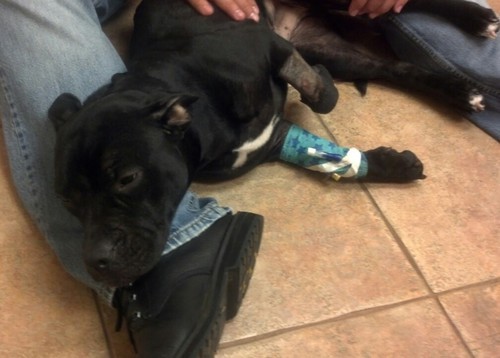Plants vs. Pets: Many Household Plants Can Be Deadly to our Four-legged Friends
Last week when I was at Publix, I noticed they had really pretty peace lilies on sale. I bought one and brought it home to prettily reside on my counter.When I got home from work on Tuesday, one of my cats was really sick. Her face was swollen and eyes gunky—the poor girl was miserable. I called the vet and asked if I could give her Benadryl until I could get her in to see them—I thought it was a cold my cats have been passing around. The Benadryl seemed to help a little bit and today, even on Benadryl, her eyes are still gunky.
This evening when I was walking by the counter, I looked at the beautiful lily and had a feeling that I needed to check toxicity on it—just a hunch. Guess what? Toxic. I started reading more on what plants, both indoor and outdoor, are toxic to cats and dogs and was very surprised at what I found. I have two azalea bushes in my backyard that are being dug out tomorrow afternoon. How many of you have azalea bushes/plants in your yard? The whole plant, even the pollen, is toxic to animals.
The Bookholt family recently experienced the devastating loss of their 9 month old puppy, Seven (pictured above), due to plant toxicity. While the family was on a short vacation for the Easter holiday, Seven ate some red berries/seeds from a Sago palm in their backyard. Their friend, who was watching the Bookholt’s three dogs, called them and told them what happened. After about an hour, Seven started throwing up, which the family thought was a good thing. When they arrived home the next day, though, they were greeted by a Seven that wasn’t himself: he was moving slowly and looking sick. The Bookholt’s Googled sago palms and learned that sago seeds are very toxic to animals—and humans. Sadly, with Sago seeds, the damage is done quickly and the treatment window is very small. Sago seeds attack internal organs, starting with the liver, which makes for a lengthy and painful deterioration. After three days of treatment, monitoring, and watching Seven suffer, the Bookholt family made the unselfish but heart-wrenching decision to alleviate Seven’s suffering and mercifully helped him cross the Rainbow Bridge.

Unfortunately, the damage was done quickly, and Seven was unable to survive her encounter with a toxic plant.
Sago and Coontie palms are all over in Florida, in private yards and even at businesses. Again, I ask: what’s in YOUR yard? Do you even know what’s planted? When you go plant shopping, do research to see what is toxic to animals? I didn’t—until now. I ask you to please do the same. I hope I won’t be the only one digging up plants in my backyard or taking indoor plants to work.
10 Most Common Poisonous Plants for Dogs AND Cats (Courtesy of Earth Clinic):
Marijuana - Animals who attempt to snack on this plant can suffer serious consequences such as diarrhea, vomiting, increased heart rate, drooling, in-coordination, and even possibly seizures and coma.
Sago Palm - While the seeds and nuts of this plant are most poisonous, the entire plant is toxic. Animals ingesting parts of this plant may suffer from diarrhea, vomiting, depression, seizures and liver failure.
Lilies - Plants of the lily variety are very poisonous to cats. Even very small amounts of this plant could cause serious kidney damage.
Tulips - The toxic portion of this plant is the actual bulb, which can cause drooling, central nervous system depression, gastrointestinal irritation, cardiac issues and convulsions.
Azalea - The toxins in azalea plants can be very severe and potentially cause drooling, diarrhea, vomiting, central nervous system weakening and depression, and in some cases possibly coma or death.
Oleander - All portions of this plant are poisonous and can cause gastrointestinal irritation, hypothermia, heart problems and possibly death.
Castor Bean - Poisoning as a result of this plant can cause abdominal pain, drooling, diarrhea, vomiting increased thirst, loss of appetite and weakness. More serious cases could also lead to dehydration, tremors, seizures, twitching muscles, coma and possibly death.
Cyclamen - The most poisonous portion of this plant is located in the root. Ingestion of the plant can cause severe vomiting and gastrointestinal irritation. In some cases death has been reported as a result.
Kalanchoe - Ingestion of this plant can cause gastrointestinal irritation and cardiac rhythm and rate problems.
Yew - Poisoning as a result of the yew plant can affect the nervous system and cause in-coordination, trembling and breathing difficulties. It may also result in gastrointestinal irritation, cardiac failure and could possibly lead to death.
There are many other well-known and common plants that can be poisonous or toxic to pets, including the following:
Apple - The seeds of an apple can be poisonous to pets.
Daffodil - Is a garden flower whose bulbs are poisonous.
Morning Glory - Is a wildflower containing poisonous seeds and roots.
Poinsettia - Is a houseplant with poisonous leaves, flowers and stems.
Rhododendron - Is an ornamental shrub whose leaves are poisonous.
Rhubarb - A garden plant with poisonous leaves.
NOTE: If you suspect that your pet has been poisoned, contact the American Society for the Prevention of Cruelty to Animals (ASPCA) Poison Control Center at 1-888-426-4435. This is 24 hour a day hotline.